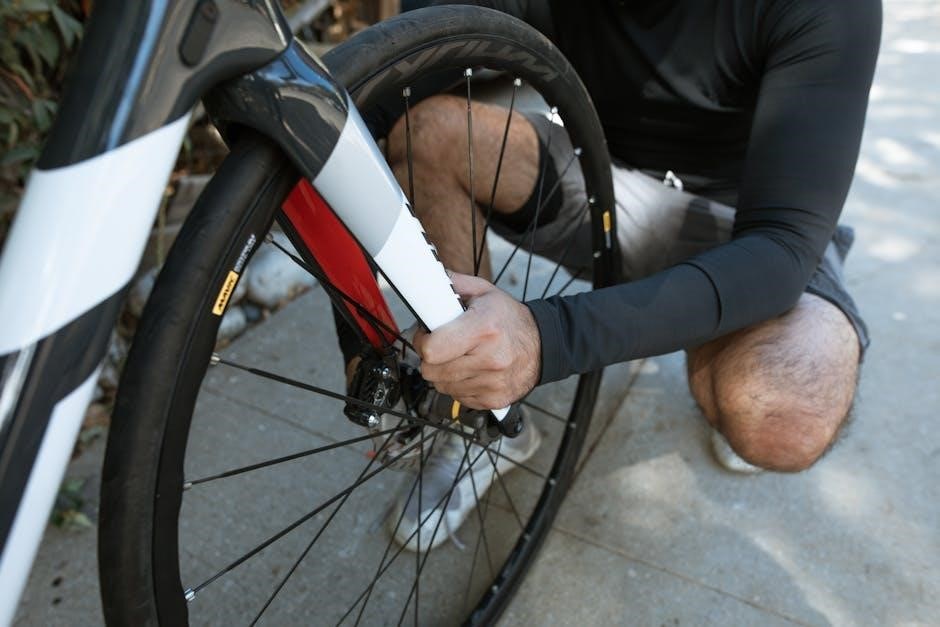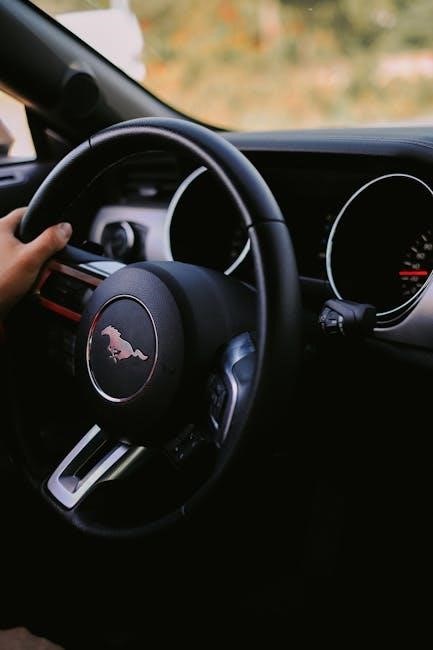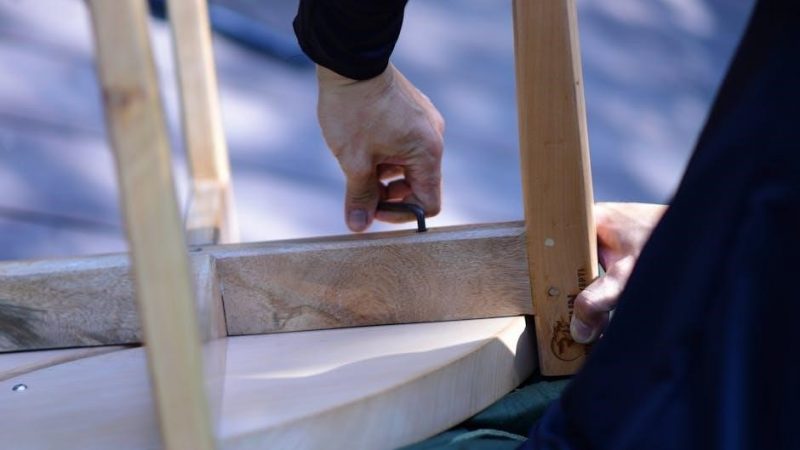how to do a burnout in a manual mustang

A burnout is a thrilling stunt where the rear tires spin, creating smoke and showcasing the car’s power․ In a manual Mustang, it’s achieved by balancing clutch and accelerator while in first gear․ Modern models offer a line lock feature for easier execution, but manual techniques are also effective․ This guide will walk you through mastering this exciting maneuver safely and effectively․

What is a Burnout?
A burnout is a driving technique where the rear tires of a vehicle spin rapidly, generating smoke and heat, while the car remains stationary․ This maneuver is often performed to showcase the car’s power or for fun․ In a manual Mustang, it involves revving the engine and strategically using the clutch and accelerator to prevent the car from moving forward․ The line lock feature in newer Mustangs simplifies this by locking the front wheels, allowing the rear wheels to spin freely․ Burnouts can also serve practical purposes, such as warming up tires before racing․ However, they require careful execution to avoid damage or loss of control, emphasizing the need for a controlled environment and proper technique․
Why Perform a Burnout in a Manual Mustang?
Performing a burnout in a manual Mustang is a way to showcase the car’s power and capabilities, often seen as a thrilling display of skill and automotive prowess․ It allows drivers to engage with their vehicle on a more dynamic level, experiencing the direct connection between the engine, transmission, and wheels․ Beyond mere showmanship, burnouts can serve practical purposes, such as warming up tires for track use, which improves traction by increasing the temperature and grip of the rubber․ Additionally, mastering the technique can enhance a driver’s control and understanding of their car’s behavior under various conditions․ Whether for fun, demonstration, or preparation, a burnout is a quintessential experience for enthusiasts of manual transmission vehicles like the Mustang․
Understanding the Basics of a Burnout
A burnout is a driving technique where the rear tires spin rapidly while the car remains stationary, creating smoke and heat․ In a manual Mustang, this is achieved by balancing clutch engagement and accelerator input․ The process relies on controlling the flow of power to the wheels while maintaining brake pressure to prevent forward movement․ The key is to generate enough friction and heat in the tires to produce smoke without losing control of the vehicle․ Proper coordination between the clutch and accelerator pedals is essential, as it determines the intensity of the burnout․ This fundamental understanding is crucial for executing the maneuver safely and effectively, especially in a manual transmission car like the Mustang․

Safety Precautions and Legal Considerations
Performing a burnout requires careful consideration of safety and legal implications․ Always assess the location, ensure the car is in good condition, and be aware of local laws․ Protective gear and emergency preparedness are essential to minimize risks and avoid legal consequences․
Choosing a Safe Location for a Burnout
Selecting a safe location for a burnout is critical to avoid accidents and legal issues․ Always choose an open, flat area with no obstacles or pedestrians nearby․ Avoid public roads, as burnouts are often illegal and dangerous․ Ideal locations include empty parking lots or private property with the owner’s permission․ Ensure the surface is asphalt or concrete, as grass or gravel can be slippery or catch fire․ Avoid wet surfaces, as they reduce traction and increase the risk of losing control․ Additionally, verify that the area is free from flammable materials and has good visibility․ Never perform a burnout near traffic or in areas where it could disturb others․ Always check for bystanders and ensure emergency vehicles can access the location if needed․ Prioritize safety to enjoy the experience responsibly․
Ensuring the Car is in Proper Condition
Before performing a burnout, ensure your manual Mustang is in optimal condition․ Check the tire pressure and tread depth, as proper tires are essential for control and smoke production․ Inspect the brake system to ensure it can handle the heat generated during the burnout․ Verify that the clutch is functioning smoothly, as it plays a crucial role in the maneuver; Additionally, check the transmission fluid levels and ensure there are no leaks․ The engine should be in good working condition, with adequate coolant levels to prevent overheating․ If your Mustang is equipped with a line lock feature, test it beforehand to ensure it engages correctly․ Avoid performing a burnout if any essential systems are malfunctioning․ A well-maintained car will perform better and reduce the risk of damage during the burnout․ Regular maintenance ensures reliability and safety during such high-stress maneuvers․
Legal Implications of Performing a Burnout
Performing a burnout in a manual Mustang can have serious legal consequences․ In most jurisdictions, burnouts are considered reckless driving and can result in fines, points on your license, or even license suspension․ Law enforcement often views burnouts as a dangerous and irresponsible act, especially in public spaces․ If a burnout leads to an accident, property damage, or injury, you could face criminal charges and civil liability․ Additionally, some areas have specific laws against excessive noise or exhibition of speed, which burnouts may violate․ Insurance companies may also deny claims if damage occurs during such activities․ Always consider the legal risks and ensure you are aware of local laws before attempting a burnout․ It’s crucial to prioritize safety and legality to avoid long-term consequences․

Vehicle Setup for a Burnout
Ensure your manual Mustang is ready for a burnout by enabling the line lock feature, found in Track Mode on newer models, which locks the front brakes․ Disable traction and stability control systems to prevent interference․ Engage first gear and disengage the clutch while pressing the accelerator to rev the engine․ Proper setup ensures a controlled and effective burnout experience․
Using the Line Lock Feature in Modern Mustangs
The Line Lock feature in modern Mustangs simplifies burnouts by locking the front brakes, allowing rear wheels to spin freely․ Found in Track Mode, it enables drivers to rev the engine without moving the car․ This feature is especially handy for those without a third pedal, making burnouts easier and more controlled․ Popular in newer models, it enhances the driving experience by providing a convenient tool for executing burnouts effortlessly․ Ensure proper setup and safety precautions before use to maximize effectiveness and safety․
Disabling Traction and Stability Control
Disabling traction and stability control is essential for performing a burnout in a manual Mustang, as these systems prevent excessive wheel spin․ To deactivate them, locate the buttons on the steering wheel or in the settings menu․ Press the traction control button until the dashboard indicator light illuminates, signaling it’s off․ Stability control may require navigating through the car’s system menu․ Ensure both systems are fully disabled to allow the rear wheels to spin freely․ For older models, this process is straightforward, while newer Mustangs may require accessing the drive mode settings․ Once disabled, the car is ready for a burnout, but always verify the systems are off to avoid interference․ This step is crucial for achieving the desired tire smoke and control during the maneuver․
Preparing the Manual Transmission for a Burnout
Preparing the manual transmission for a burnout ensures smooth clutch engagement and optimal power transfer․ Start by warming up the engine and transmission with a short drive to prevent shock from cold components․ Next, shift into first gear and engage the clutch pedal fully․ Ensure the car is stationary and apply the brake firmly with your left foot․ With the clutch held, rev the engine to increase RPM, allowing the tires to spin freely when the clutch is released․ Proper preparation helps in achieving a controlled burnout, minimizing wear on the transmission and maximizing tire smoke․ Keep the car in first gear throughout the process to maintain torque delivery․ This setup is crucial for a successful burnout in a manual Mustang, ensuring both safety and performance․

Step-by-Step Guide to Performing a Burnout
Engage first gear, hold the clutch, and rev the engine․ Release the clutch slowly while pressing the brake for a controlled, smoky burnout in your manual Mustang․
Starting with First Gear and Clutch Engagement
Begin by shifting your manual Mustang into first gear while fully engaging the clutch pedal with your left foot․ Ensure the car is stationary and secure, applying the brake with your right foot if necessary․ With the transmission in first gear, you set the foundation for initiating the burnout․ Keep your left foot firmly on the clutch, preparing to control the power delivery․ This initial step is crucial as it readies the vehicle to harness engine power effectively for the burnout․ Proper clutch engagement ensures smooth acceleration when you release it, which is vital for generating the desired tire smoke․ Always maintain focus and control during this phase to ensure safety and optimal performance․

Reving the Engine While Holding the Clutch
With the car in first gear and the clutch fully engaged, use your right foot to gently press the accelerator, gradually increasing the engine RPMs․ Keep your left foot firmly on the clutch pedal to prevent the car from moving forward․ As you rev the engine, focus on maintaining control and balance․ Avoid flooring the accelerator immediately, as this could cause the wheels to spin uncontrollably․ Instead, aim for a steady increase in power to build smoke and maintain traction․ This step is critical for generating the necessary torque and heat in the tires, which is essential for a successful burnout․ Always keep your eyes on the road and be prepared to adjust your inputs as needed to stay in control․
Dumping the Clutch and Applying Brake Pressure
Once the engine is revved and the clutch is held, prepare to dump the clutch by quickly releasing the clutch pedal while maintaining accelerator input․ This action transfers power to the wheels, initiating the burnout․ Simultaneously, apply gentle to moderate brake pressure with your left foot to prevent the car from moving forward․ The balance between accelerator and brake pressure is crucial for maintaining control and maximizing smoke production․ Keep your eyes on the road and be ready to adjust inputs as needed․ Proper timing and coordination ensure a smooth, controlled burnout while minimizing the risk of losing traction or skidding․ This step requires practice to master the delicate balance between power delivery and braking for optimal results․

Maintaining Control During the Burnout
Maintaining control during a burnout is essential for safety and achieving the desired effect․ Keep your eyes on the road and surrounding environment to ensure no obstacles are present․ Balance the clutch, accelerator, and brake inputs smoothly to avoid sudden loss of traction․ As the tires spin, gently adjust the accelerator to control the intensity of the smoke․ Be prepared to release the accelerator or apply more brake pressure if the car starts to move forward or lose stability․ Practice is key to mastering this balance, as it requires precise coordination between pedals․ Always remain calm and focused to maintain control throughout the burnout, ensuring a safe and impressive display of power․

Advanced Techniques for a Smokier Burnout
Mastering advanced techniques like the brake stand method or feathering the clutch can enhance smoke production․ Adjusting tire pressure and optimizing throttle input also contribute to a smokier burnout․ These methods require precise control and practice to achieve the desired effect without losing traction or damaging the car․ Balancing acceleration and brake pressure ensures maximum smoke while maintaining stability․ Experimenting with different techniques and setups can help drivers refine their burnout skills for a more dramatic display of power and control․
Using the Brake Stand Method
The brake stand method is an advanced technique for achieving a smokier burnout in a manual Mustang․ By pressing the brake pedal firmly with your left foot, you lock the front wheels while revving the engine․ With the car in first gear and the clutch disengaged, slowly increase the RPM to build power․ Once ready, release the clutch pedal swiftly while maintaining brake pressure․ This causes the rear wheels to spin aggressively, creating thick smoke․ The key is to balance brake pressure and throttle input to sustain the burnout without losing control․ Practice this method in a controlled environment to master the timing and pressure application․ Proper execution enhances the visual effect, making it a favorite among enthusiasts․ Always ensure safety and legal compliance when performing this maneuver․
Adjusting Throttle and Clutch for Maximum Smoke
Maximizing smoke during a burnout in a manual Mustang requires precise coordination of the throttle and clutch․ Start by revving the engine to a high RPM while holding the clutch disengaged․ Gradually release the clutch pedal to the point where the rear wheels begin to spin, but not so much that the car moves forward․ Simultaneously, feather the throttle to maintain consistent power delivery to the wheels․ The goal is to find the sweet spot where the tires smoke heavily without losing traction completely․ Higher RPM typically produces more smoke, but be cautious not to over-rev, as this can damage the engine or cause the car to break loose․ Practice varying clutch and throttle inputs to achieve the perfect balance for thick, smoky burnouts while maintaining control of the vehicle․ This technique enhances the visual appeal of the burnout and showcases mastery of the manual transmission․ Always ensure safety and legal compliance when performing this maneuver․
Understanding the Role of Tire Pressure
Tire pressure plays a significant role in achieving an effective burnout in a manual Mustang․ Lowering the tire pressure increases the surface area in contact with the pavement, generating more friction and heat, which enhances smoke production․ Typically, reducing pressure to around 25-30 PSI is recommended for optimal results․ However, avoid excessive deflation, as it can damage the tires or cause uneven wear․ Street tires may not produce as much smoke as dedicated drag tires due to their tread design, but proper pressure adjustment can still yield impressive results․ Experimenting with tire pressure can help achieve the desired balance between smoke and control during a burnout․ Always ensure the tires are re-inflated to the recommended level after the burnout to maintain safety and performance on the road․

Troubleshooting Common Issues
Common issues during a burnout include the car not performing as expected, line lock malfunctions, and overheating․ These can be addressed by checking tire pressure, transmission setup, and cooling systems․
Why the Car Might Not Perform a Burnout
If your manual Mustang isn’t performing a burnout, it could be due to improper tire pressure, traction control being enabled, or incorrect clutch and brake techniques․ Worn tires with low tread may also fail to produce smoke․ Additionally, issues with the line lock feature or transmission setup can prevent a burnout․ Ensure the car is in first gear and the clutch is fully disengaged before revving․ If the brakes are applied too aggressively, the rear wheels may not spin freely․ Finally, check for any electronic aids or safety features that might interfere․ Addressing these factors can help resolve the issue and achieve the desired burnout․
Issues with the Line Lock Feature
Issues with the line lock feature can hinder a burnout in a manual Mustang․ If the feature isn’t activating properly, it might be due to a software glitch or incorrect mode selection․ Ensure the car is in Track Mode and the line lock is enabled correctly․ Improper brake pedal application can also disrupt the function, so hold the pedal firmly․ If the front wheels unlock prematurely, it could prevent the rear wheels from spinning․ Additionally, worn brake pads or low brake fluid might reduce the effectiveness of the line lock․ If problems persist, resetting the system or consulting a professional may be necessary to resolve the issue and achieve a successful burnout․
Overheating During a Burnout
Overheating during a burnout in a manual Mustang can occur due to excessive friction and heat generated by the spinning tires․ Prolonged burnouts, especially in high-performance vehicles, can strain the engine and braking systems․ Modern Mustangs, with their advanced cooling systems, are designed to handle moderate burnouts, but ignoring overheating warnings can lead to damage․ If the car begins to overheat, stop the burnout immediately and allow the engine and brakes to cool down․ Ensure proper cooling system maintenance to prevent such issues․ Avoiding prolonged burnouts and monitoring temperature gauges can help mitigate overheating risks․ Always prioritize cooling down after a burnout to protect your car’s components and ensure long-term reliability․

Post-Burnout Procedures
After a burnout, allow the tires and brakes to cool down to prevent damage․ Inspect for wear and reset any systems like traction control or line lock․ This ensures safety and prevents long-term wear․
Cooling Down the Tires and Brakes
After performing a burnout, it’s crucial to allow your tires and brakes to cool down․ Prolonged heat can damage the rubber and braking components․ Start by driving slowly for a few minutes to let the tires naturally dissipate heat․ Avoid sudden stops or aggressive driving during this period․ If possible, find a safe place to park and let the car sit idle for a short time․ This cooling process ensures the integrity of your tires and brakes, preventing potential damage from excessive heat buildup․ Always prioritize cooling down after a burnout to maintain your car’s performance and safety․
Checking for Damage After a Burnout
After performing a burnout, it’s essential to inspect your car for any potential damage․ Start by examining the tires for uneven wear or excessive heat damage, as prolonged spinning can weaken the rubber․ Check the wheel bearings and axles for stress or damage, as the strain from a burnout can cause premature wear․ Inspect the brake system, including pads and rotors, to ensure they haven’t overheated or sustained damage․ Look for any signs of smoke or unusual odors, which could indicate overheated components․ Finally, review the clutch and transmission for smooth operation, as aggressive clutch engagement during a burnout can strain these systems․ Addressing any issues promptly will help maintain your car’s performance and longevity․
Resetting the Car’s Systems
After completing a burnout, it’s important to reset your car’s systems to ensure proper functionality․ Start by turning off the line lock feature if it was activated, as it’s only intended for burnouts․ Re-enable traction and stability control to restore safety systems․ Allow the car to idle for a few minutes to cool down the clutch, transmission, and brakes, which may have overheated during the maneuver․ Check the dashboard for any warning lights or error messages that may indicate system stress․ Finally, shift into neutral and let the car rest before driving normally; This process helps prevent long-term damage and ensures your Mustang operates smoothly after the burnout․
Mastery of a burnout in a manual Mustang requires practice, patience, and attention to safety․ With proper technique and control, you can enjoy this thrilling maneuver responsibly․
Final Tips for Mastering the Burnout
Mastering a burnout in a manual Mustang requires consistent practice and a focus on precision․ Start by ensuring your car is in good condition, with proper tire pressure and functioning brakes․ Use the line lock feature if available, as it simplifies the process․ When performing a burnout, maintain steady throttle input and gradually release the clutch to avoid abrupt jerks․ Always keep your foot near the brake to control speed․ Practice in a safe, open area away from traffic․ Over time, you’ll develop the muscle memory needed for smooth, controlled burnouts․ Remember, safety and responsibility are key to enjoying this exhilarating maneuver․
Enjoying the Experience Responsibly
Performing a burnout in your manual Mustang can be an exhilarating experience, but it’s crucial to do so responsibly․ Always choose a safe, open space away from traffic and bystanders to avoid accidents․ Be mindful of local laws and regulations, as burnouts are often illegal on public roads․ Respect your vehicle by ensuring it’s in proper condition and not overheating․ Avoid reckless behavior that could damage your car or harm others․ Remember, the thrill of a burnout is best enjoyed when done safely and within legal boundaries․ By being responsible, you can savor the excitement while protecting yourself, your car, and those around you․





